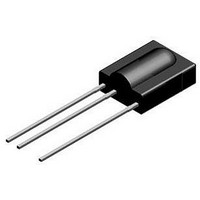TSOP31237 Vishay, TSOP31237 Datasheet - Page 6

TSOP31237
Manufacturer Part Number
TSOP31237
Description
IR Receiver Module
Manufacturer
Vishay
Datasheet
1.TSOP31237.pdf
(9 pages)
Specifications of TSOP31237
Transmission Range
45m
Directivity
45°
Supply Voltage Range
2.5V To 5.5V
Opto Case Style
Through Hole
Operating Temperature Range
-25°C To +85°C
Carrier Frequency
36.7kHz
Supply Current
450µA
Lead Free Status / RoHS Status
Lead free / RoHS Compliant
Available stocks
Company
Part Number
Manufacturer
Quantity
Price
TSOP312..
Vishay Semiconductors
Suitable Data Format
The circuit of the TSOP312.. is designed in that way
that unexpected output pulses due to noise or distur-
bance signals are avoided. A bandpass filter, an inte-
grator stage and an automatic gain control are used
to suppress such disturbances.
The distinguishing mark between data signal and dis-
turbance signal are carrier frequency, burst length
and duty cycle.
The data signal should fulfill the following conditions:
• Carrier frequency should be close to center fre-
quency of the bandpass (e.g. 38 kHz).
• Burst length should be 10 cycles/burst or longer.
• After each burst which is between 10 cycles and 70
cycles a gap time of at least 14 cycles is necessary.
• For each burst which is longer than 1.8 ms a corre-
sponding gap time is necessary at some time in the
data stream. This gap time should be at least 4 times
longer than the burst.
• Up to 800 short bursts per second can be received
continuously.
Some examples for suitable data format are: NEC
Code (repetitive pulse), NEC Code (repetitive data),
Toshiba Micom Format, Sharp Code, RC5 Code,
RC6 Code, R-2000 Code, Sony Code.
When a disturbance signal is applied to the
TSOP312.. it can still receive the data signal. How-
ever the sensitivity is reduced to that level that no
unexpected pulses will occur.
Some examples for such disturbance signals which
are suppressed by the TSOP312.. are:
• DC light (e.g. from tungsten bulb or sunlight)
• Continuous signal at 38 kHz or at any other fre-
quency
• Signals from fluorescent lamps with electronic bal-
last with high or low modulation
( see Figure 15 or Figure 16 ).
www.vishay.com
6
Figure 16. IR Signal from Fluorescent Lamp with high Modulation
Figure 15. IR Signal from Fluorescent Lamp with low Modulation
16920
16921
0
0
IR Signal from fluorescent
lamp with high modulation
IR Signal from fluorescent
lamp with low modulation
5
5
Time ( ms )
Time ( ms )
10
10
15
15
Document Number 82217
20
20
Rev. 2, 19-May-03
VISHAY










